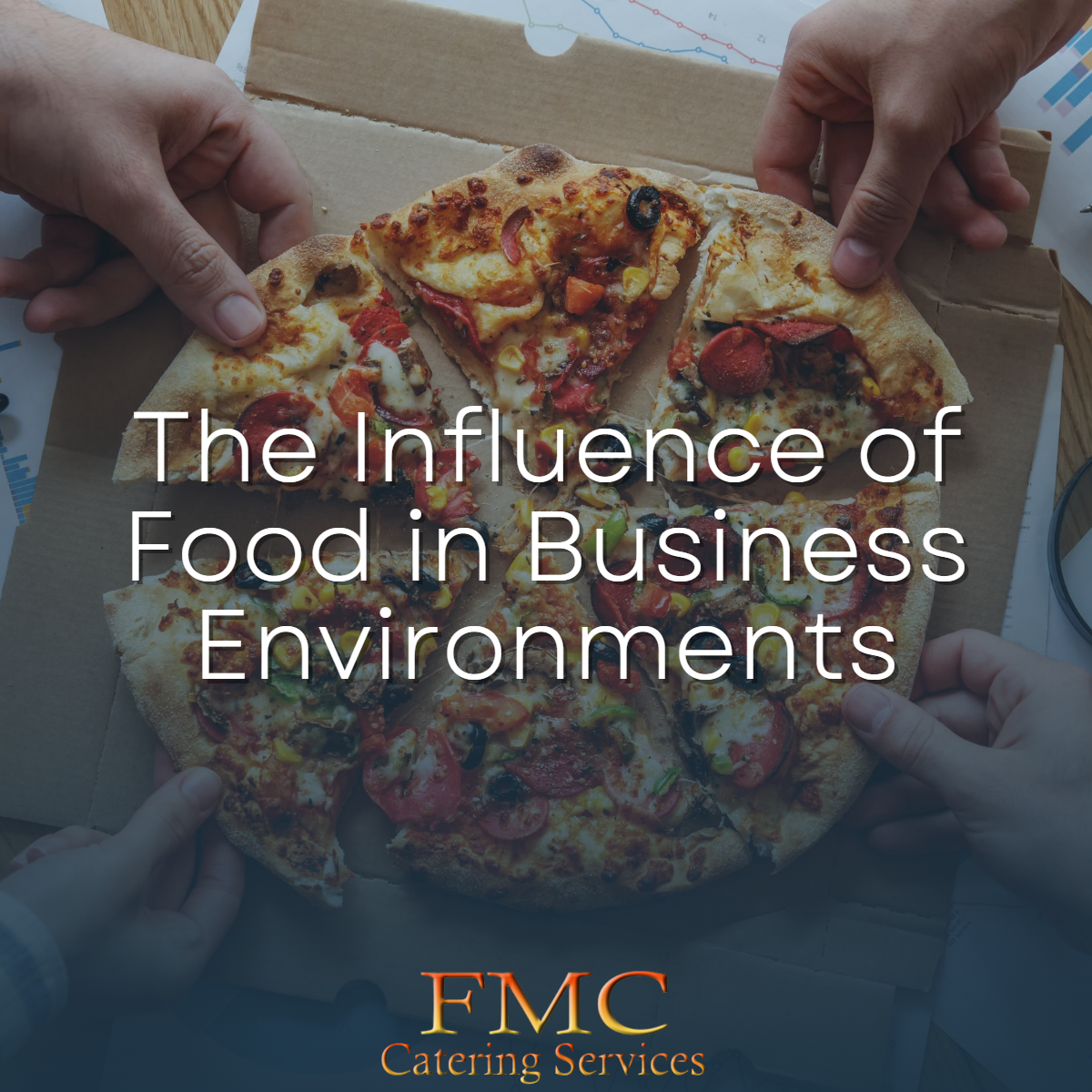Picture this: lunchtime in the bustling office, and the aroma of freshly brewed coffee and mouthwatering dishes wafts through the air. Colleagues gather around the communal table, engaging in lively conversations while savoring their meals. It’s more than just a simple lunch break; it’s a moment of connection, nourishment, and rejuvenation. Welcome to the world where food holds sway in business environments, impacting employee satisfaction, productivity, and company culture.
You see, food has a way of bringing people together like nothing else. It transcends the confines of conference rooms and boardrooms, creating opportunities for genuine human connection. Whether sharing a homemade treat during a team meeting or gathering at the local café for a quick coffee break, these food-related moments forge bonds among colleagues. They foster community, sharing laughter, exchanging ideas, and forming friendships. These connections lay the foundation for a positive and thriving workplace culture.
But food’s influence doesn’t stop there. Have you ever noticed how a well-timed snack or a nutritious meal can make all the difference in your focus and energy levels? It’s no coincidence. A business coach will tell you that by prioritizing healthy food options, businesses demonstrate their commitment to their employees’ well-being. A well-fed workforce is motivated, ready to conquer challenges, think creatively, and excel. Employees feel valued and cared for when the office pantry is stocked with healthy choices, resulting in heightened productivity and appreciation.

Beyond the impact on satisfaction and productivity, food also plays a starring role in shaping the fabric of company culture. Food-centered celebrations create lasting memories and a shared sense of identity. They foster a feeling of belonging, uniting employees from diverse backgrounds for a common purpose. Food becomes a delicious catalyst for celebration and togetherness from birthdays to project milestones.
Understanding the profound significance of food in business environments is a game-changer. By embracing this understanding, businesses can purposefully incorporate food-related initiatives into their workplace practices, reaping the benefits of a well-nourished, connected, and vibrant workforce. From healthy meal options to team-building activities centered around culinary experiences, the possibilities are as limitless as the flavors tantalize our taste buds.
So, as we embark on this delectable journey through the impact of food in the business world, let’s savor every bite and appreciate the profound role that food plays in enhancing employee satisfaction, fueling productivity, and shaping a unique company culture. Together, we’ll unlock the secrets to harnessing the transformative power of food in the workplace. Bon appétit!
The role of food in workplace culture
Food can remarkably shape workplace culture, creating an environment where employees feel connected, engaged, and valued. It goes beyond the act of nourishment and becomes a catalyst for fostering a sense of community and belonging within the organization.
Shared meals and food-related activities are vital in building a strong camaraderie among colleagues. When employees gather around a table to enjoy a meal, barriers dissolve, and conversations flow more naturally. It’s a time to connect personally, sharing stories, experiences, and laughter. These shared meals become opportunities for employees to bond, forge friendships, and develop deeper relationships beyond daily work interactions. As a result, a sense of community and support emerges, creating a positive and cohesive work culture.

Food can also be harnessed as a powerful tool for team building and employee engagement. Organizing food-related activities such as cooking competitions, potluck lunches, or themed food events encourages collaboration and teamwork. When employees come together to prepare and enjoy meals, they learn to communicate effectively, delegate tasks, and appreciate each other’s contributions. These activities promote cooperation, trust, and a sense of shared achievement, strengthening teamwork and boosting employee morale. Moreover, engaging in culinary experiences allows individuals to showcase their creativity, fostering a sense of empowerment and pride in their work.
Beyond team building, food is crucial in creating a positive and inclusive work environment. By offering diverse food options catering to various dietary preferences and cultural backgrounds, businesses demonstrate their commitment to inclusivity and respect for diversity. When employees feel that their food choices are acknowledged and respected, it creates a sense of belonging and acceptance.
Moreover, by incorporating different cuisines and flavors, organizations celebrate the richness of cultural diversity within their workforce. This fosters an environment where individuals feel valued for their unique identities and experiences, leading to increased employee satisfaction and a stronger sense of community.

Food as a driver of productivity
The connection between food and productivity is undeniable. What we eat directly impacts our cognitive function, energy levels, and ability to focus. By prioritizing nutritious meals and snacks, businesses can fuel their employees’ bodies and minds, enhancing productivity and overall well-being.
Proper nutrition plays a crucial role in supporting optimal cognitive function. Our brains require a steady supply of nutrients to function at their best. When we provide our bodies with nourishing foods, such as fruits, vegetables, whole grains, and lean proteins, we supply our brains with the essential nutrients they need. These nutrients, including vitamins, minerals, and antioxidants, support brain health, enhance memory and concentration, and improve cognitive performance. On the other hand, consuming excessive amounts of unhealthy, processed foods can lead to sluggishness, brain fog, and decreased productivity.
By offering nutritious meals and snacks, businesses can provide employees with the fuel they need to stay energized and focused throughout the workday. Balanced meals that incorporate a variety of nutrients, such as complex carbohydrates, lean proteins, and healthy fats, provide sustained energy levels and prevent the mid-afternoon slump. Additionally, healthy snacks, such as nuts, fruits, or yogurt, offer a quick energy boost without the crash associated with sugary or processed snacks. Employees can maintain optimal energy levels, improving productivity and efficiency when accessing healthy options.
Moreover, the availability of healthy food options demonstrates a company’s commitment to employee well-being. When businesses prioritize employee health by providing nutritious meals, it sends a powerful message that their employees’ vitality and productivity are valued. By fostering a workplace environment that supports healthy eating habits, businesses can reduce the risk of chronic diseases, enhance overall well-being, and improve employee engagement and satisfaction.
Culinary experiences for business networking
Food has long been recognized as a powerful tool for fostering connections and building relationships. In the realm of business networking, the role of food becomes even more significant. Whether networking events, conferences, or client meetings, shared meals and dining experiences provide valuable opportunities for relationship building and establishing rapport.
Food is a natural icebreaker and conversation starter when professionals come together for networking events or conferences. Gathering around a table to enjoy a meal creates a relaxed and informal environment where individuals can engage in meaningful conversations. Breaking bread together develops a shared experience, facilitating conversation and fostering connections. As attendees savor delicious dishes, they can discuss industry trends, share insights, and exchange ideas. These interactions build trust, camaraderie, and rapport, laying the groundwork for potential collaborations and future business opportunities.
Client meetings that involve food can also enhance the client-business relationship. Sharing a meal with clients goes beyond discussing business matters; it allows for a more personal connection to develop. Dining together allows for getting to know clients deeper, understanding their preferences, and engaging in casual conversations. This relaxed atmosphere can help build trust and strengthen the professional bond. When clients feel valued and appreciated, they are more likely to develop a sense of loyalty towards the business and continue the partnership.

When it comes to leveraging food-related opportunities to create memorable business connections, consider the following tips:
- Choose unique dining venues: Opt for restaurants or venues that offer a distinctive and memorable experience. Look for places with a unique ambiance, innovative menus, or cultural significance. This can make a lasting impression on your guests and create a memorable connection.
- Personalize the dining experience: Tailor the dining experience to your guests’ preferences. Take into account their dietary restrictions, cultural backgrounds, or culinary preferences. Showing that you’ve considered their needs and preferences demonstrates thoughtfulness and enhances the personal connection.
- Incorporate interactive elements: Look for dining experiences that involve interactive aspects such as cooking classes, wine tastings, or food pairing sessions. These activities allow guests to engage, learn, and bond over shared experiences. The interactive nature of the event fosters a sense of camaraderie and creates lasting memories.
- Foster conversation and networking: Arrange seating arrangements or activities encouraging conversation and networking. Consider using round tables or small group activities that facilitate interaction among attendees. This can help break the ice, encourage open discussions, and create connections among participants.
- Offer diverse food options: Accommodate various dietary preferences and restrictions by offering a diverse range of food options. Include vegetarian, vegan, gluten-free, and other unique dietary options. Ensuring all guests enjoy the meal comfortably shows inclusivity and respect for their needs.
- Share local culinary experiences: If you’re hosting guests from out of town, showcase local culinary specialties. Introduce them to regional dishes, local ingredients, or signature flavors. This provides a unique dining experience and highlights the cultural richness of the location, creating a special connection.
- Follow up with personalized gestures: After the dining experience, follow up to maintain the connection. Send a thank-you note or a small food-related gift that reflects the shared experience. This thoughtful gesture reinforces the connection made during the meal and keeps your business in mind.
Leveraging food-related opportunities to create memorable business connections is about more than just the food itself. It’s about creating an experience that fosters genuine relationships, engages participants, and leaves a lasting impression. By incorporating these tips into your networking events or client meetings, you can create memorable moments that strengthen relationships and contribute to the success of your business connections.
Nurturing innovation through food
Food is magical to ignite creativity and inspire innovation in business settings. We can create an environment fostering innovation and spark fresh ideas by embracing food-related initiatives.
Informal gatherings centered around food provide the perfect backdrop for creativity to flourish. These relaxed settings encourage open dialogue and free-flowing ideas, whether a casual team lunch or a brainstorming session over coffee and pastries. Sharing a meal cultivates a sense of camaraderie, allowing us to connect on a deeper level and build trust. In these moments, our minds are open, inhibitions are lowered, and we can freely explore diverse perspectives and unconventional approaches.

Beyond the social aspect, enjoying food stimulates our senses and sparks new connections in our minds. It’s amazing how a delicious dish can trigger a flurry of creative thoughts and associations. Combining flavors, textures, and aromas can inspire innovative thinking and unlock fresh insights.
Many forward-thinking companies have recognized the power of food-related initiatives in driving innovation. They’ve created innovative kitchens or designated spaces where employees can experiment with new recipes and culinary concepts. These spaces become playgrounds for creativity, encouraging collaboration and exploring new ideas.
Food innovation workshops have also gained popularity, bringing employees from different departments together to explore emerging food trends and develop groundbreaking concepts. These workshops catalyze cross-functional collaboration, allowing diverse perspectives to blend and spark innovative solutions.
Additionally, companies have introduced food-related challenges and competitions, pushing employees to think outside the box and develop innovative food products, packaging designs, or menu items. These challenges inspire creativity and foster a healthy spirit of friendly competition, driving teams to push boundaries and reach new heights.
Overcoming challenges and considerations
Implementing food-related programs or initiatives in business environments can face its fair share of challenges. It’s essential to be aware of these challenges and consider various factors such as dietary restrictions, cultural sensitivities, and budgetary constraints.
One common challenge is accommodating dietary restrictions. As businesses strive to provide inclusive food experiences, it’s essential to consider individuals with dietary restrictions or specific dietary preferences. This may include catering to vegetarian, vegan, gluten-free, or allergy-sensitive diets. By offering diverse food options, we can ensure that everyone feels included and can fully participate in the culinary experiences.
Cultural sensitivities are another crucial consideration. In diverse work environments, respecting and acknowledging cultural differences regarding food choices and practices is vital. This includes being mindful of religious dietary restrictions, cultural food preferences, and traditions. By incorporating cultural diversity into our food-related initiatives, we can create an inclusive and respectful environment where everyone feels valued.
Budgetary constraints can also pose a challenge when implementing food-related programs. While we aspire to provide exceptional culinary experiences, it’s essential to consider the financial limitations. This may involve exploring cost-effective alternatives, negotiating with vendors, or seeking creative solutions aligned with the budget. By being mindful of budget constraints, we can balance providing quality food experiences and managing costs effectively.
To overcome these challenges, communication and planning are essential. It’s crucial to involve employees and stakeholders in the decision-making process. Here are some more tips for you to overcome these challenges:
- Conduct a survey or needs assessment: Gather information about your employees’ dietary preferences, restrictions, and cultural backgrounds. Conducting a survey or needs assessment will help you understand your workforce’s diverse needs and preferences.
- Offer various options: Provide diverse food options for different dietary needs and preferences. Include vegetarian, vegan, gluten-free, and allergy-friendly choices in your menu selections. This ensures everyone can access suitable food options and feel included in the culinary experiences.
- Communicate clearly and provide information: Communicate the food options available, including ingredient lists and potential allergens, to employees. Display labels or signage near food stations to indicate specific dietary information. This helps individuals make informed choices and ensures their safety and well-being.
- Partner with inclusive vendors: Collaborate with food vendors or catering services that understand and specialize in catering to diverse dietary needs. Work with experienced vendors to accommodate various dietary restrictions and offer your employees multiple options.
- Embrace cultural diversity: Celebrate and embrace cultural diversity within your workplace by incorporating food from different cultures and traditions. This can be done through themed food events or by incorporating diverse cuisines into your regular menu rotation. You create an inclusive and welcoming environment by showcasing and appreciating other culinary traditions.
- Provide education and resources: Educate employees about different dietary needs and cultural practices related to food. Offer resources such as workshops, seminars, or newsletters on dietary restrictions, cultural food practices, and inclusive eating habits. This promotes awareness, understanding, and respect among employees.
- Encourage collaboration and participation: Foster community and collaboration by organizing potluck-style or team-building activities around food. Encourage employees to share their favorite dishes or traditional recipes, allowing them to showcase their cultural heritage and create connections through food.
- Regularly evaluate and adapt: Continuously assess your food-related initiatives’ effectiveness and gather employee feedback. This feedback will help you identify areas for improvement and make necessary adjustments to meet your diverse workforce’s needs and preferences.
By implementing these tips, you can effectively manage food-related aspects in diverse business settings. Creating an inclusive and accommodating food environment fosters employee satisfaction, engagement, and a sense of belonging. It also promotes a positive company culture that embraces diversity and enhances workplace well-being.

Conclusion
The influence of food in business environments is undeniable. It can shape workplace culture, enhance productivity, foster innovation, and create memorable connections. By recognizing and harnessing the power of food, businesses can create positive experiences that contribute to employee satisfaction and overall success.
Shared meals and food-related activities bring people together, fostering a sense of community and camaraderie among employees. They provide opportunities for team building, relationship building, and engagement. Moreover, nutritious meals and snacks boost employee energy, focus, and overall well-being, increasing productivity.
Recognizing the influence of food in business environments and integrating it into workplace culture can profoundly impact employee satisfaction, engagement, and overall success. It fosters a positive and inclusive atmosphere where employees feel valued, connected, and motivated.
As businesses move forward, it is crucial to explore creative ways to leverage the power of food in creating favorable business experiences. The possibilities are endless, whether it’s organizing food-related team-building activities, incorporating cultural diversity into menus, or nurturing a culture of innovation through food-related initiatives.
So, let’s embrace the influence of food and make it an integral part of our business environments. Doing so can create workplaces that nourish our bodies and foster collaboration, inspiration, and a strong sense of belonging.
Look no further if you’re searching for a food provider for your next business event that prioritizes nutrition and flavor! Contact us today to ensure a delightful and nourishing culinary experience that will leave a lasting impression on your attendees.

